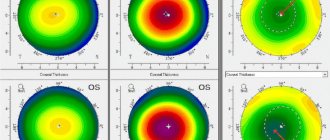Indications and contraindications for LASIK surgery
Laser vision correction through LASIK surgery is performed for:
- Farsightedness +6 diopters;
- Myopia up to – 15 diopters;
- Astigmatism up to ±3 diopters.
Indications for treatment are limited to visual impairment and therefore few in number, while there are many more contraindications to the procedure. It is not performed on persons under the age of majority, as well as on pregnant women and nursing mothers.
Absolute contraindications include:
- Autoimmune diseases that impede normal corneal regeneration;
- Pathology of immunity;
- Systemic connective tissue diseases;
- Absence of one eye (they will not do LASIK on the only one that is intact);
- Increased intraocular pressure;
- Keratoconus;
- Small thickness of the cornea (less than 450 microns);
- Clouding of the cornea (cataract);
- Progression of myopia;
- Retinal detachment, which was treated surgically;
- Viral eye infection (herpes).
There are also relative contraindications to LASIK surgery. These are some common diseases - diabetes, acute mental disorders, presence of a pacemaker. Pregnancy and breastfeeding may be a temporary obstacle, since hormonal imbalance can disrupt normal corneal regeneration.
Laser vision correction cannot be performed for acute inflammatory eye diseases. They must be treated. Retinal pathology may require preliminary laser coagulation, after which LASIK is already possible. Corneal scars can be a relative obstacle to the procedure.
How is LASEK eye surgery performed?
The doctor may choose this method of laser correction if a person has contraindications to PRK or LASIK procedures. The LASEK operation is carried out in several stages:
- The doctor separates the epithelial flap of the cornea.
- Laser correction is performed on the anterior layers of the cornea.
- When the corneal shape correction is completed, the flap is returned to its original location.
- A soft bandage lens is placed over the eye to protect it for up to five days.
- Repeat the manipulations for the second eye.
The main difference between LASEK and other techniques is that the laser affects only the surface layer of the cornea, so it is prescribed for thinned corneas. Because the epithelium is not completely removed as with PRK, healing occurs more quickly and less painfully.
All laser vision correction operations have their advantages; in each specific case, the ophthalmologist makes a choice taking into account the characteristics of a particular person. Sometimes refractive surgery is contraindicated for a patient, and then the best way to correct vision is contact lenses from reliable brands - Johnson & Johnson, CooperVision, Bausch & Lomb.
Benefits of LASIK
Vision correction using a laser beam has many advantages compared to surgical techniques, which makes this particular procedure very attractive for a wide range of patients:
- Short rehabilitation period – you can leave the clinic on the day of treatment and safely begin work the next day;
- Possibility of outpatient treatment;
- Painless and quick procedure;
- No damage to the upper layer of the cornea;
- Local anesthesia in the form of drops is safe and well tolerated;
- It is possible to treat both eyes at once;
- Minimal risk of complications;
- Restoration of vision on the day of the procedure;
- Persistent positive result;
- Availability.
Advantages of the technique
Lasik has a lot of advantages, for which it is appreciated by both patients and doctors themselves. The main advantages of this method of vision correction:
- the ability to return to work or study as soon as possible;
- the operation is performed on an outpatient basis and there is no need to stay in the hospital;
- no seams;
- Local anesthesia is used during surgery, which patients usually tolerate well;
- the ability to cope with even the most complex cases of visual impairment;
- fast rehabilitation times;
- the ability to stop wearing glasses on the first day after surgery;
- high efficiency and minimal risks;
- simplicity and high speed, accessibility.
The risks of the operation are minimal
On a note! Lasik is not as wonderful as it seems. The main disadvantage of the operation is its relatively high cost.
The principle of laser vision correction method
The cornea is a transparent light-refracting shell of the eye, the features of which, like the lens and other components of the organ of vision, determine whether the image will fall on the retina or outside it. The principle of LASIK is based on changing the shape of the cornea at the front of the eye, through which the image is focused onto the retina.
Treatment of vision pathology using a laser beam has been practiced since the end of the last century, and now both the technique itself and the installations used for this have changed significantly. The laser has become more accurate and faster, and preoperative diagnostics have improved. The device for the procedure successfully combines a radiation source, an operating microscope and a microkeratome.
Standard LASIK surgery involves the action of an ultraviolet beam aimed at the deep layers of the cornea. At the same time, the cells heat up, their layers evaporate, and the cornea changes its shape. An indispensable condition is the use of a microkeratome, capable of separating the thinnest upper layer of the cornea.
Femto LASIK is a more modern procedure in which correction occurs non-contactly and does not require the use of a microkeratome. The infrared laser beam itself is capable of creating a thin and neat cut of the cornea, it can be directed to the desired depth of the eye shell, it is very accurate, and the treatment process is controlled at all stages, taking into account the individual characteristics of a particular patient. With femto LASIK manipulation, it is possible to obtain ideal corneal characteristics, thereby achieving the best treatment results and shortening the recovery period.
The only significant drawback of the femtosecond laser is its high cost, which is why the equipment is not very common in clinics in Russia and neighboring countries. For the same reason, the operation itself is much more expensive than LASIK.
In popular publications and advertising you can find the term “super LASIK”, which is not used in the scientific literature and among manufacturers of surgical equipment. It means the same LASIK operation, and the prefix “super” is a common advertising ploy designed to attract more patients.
An obstacle to LASIK surgery can be an excessively thin cornea, which cannot be safely cut with a microkeratome. For such cases , the Epi LASIK technique has been developed, when only the upper corneal layer is peeled off using an epithelial keratome, then it is returned to its place and covered with a protective lens for several days to accelerate corneal regeneration. Otherwise, the operation is no different from the LASIK technique.
Despite the filigree of the Epi LASIK operation, it is considered very safe. There is not a single case recorded in the world in which the cornea was perforated or clouded as a result of such treatment. 9 out of 10 patients were ready to return to work the next day after treatment.
Video: laser correction of myopia femto lasik
Features of the LASIK technique
The LASIK (Laser-in-situ-keratomileusis) vision correction method was created much earlier than the previously described technique. This type of intervention is actually performed according to an already familiar algorithm:
- The laser makes an incision on the surface of the corneal layer of the eye.
- The flap, in the shape of a round valve on a thin stalk, is moved to the side (and not up, as in the previous case) using a microkeratome - a miniature device reminiscent of a shaving machine.
- An excimer laser vaporizes part of the corneal tissue to form a lens-shaped bulge.
- The wedge returns to its place.
The intervention is performed using a standard excimer laser with a wavelength of 190 microns or more. The length, area of laser exposure and other parameters are set by a computer program. It contains values that do not allow tissues to heat up by more than 1-2 degrees, and the maximum depth of beam penetration does not exceed 1/5 of the thickness of the cornea.
Since more precise digital settings and additional drugs that accelerate regeneration are not used during the LASIK procedure, recovery takes up to 2 weeks. Until this time, vision remains insufficiently clear. There may be a slight blur in the field of vision.
Planning and preparation for laser vision correction
LASIK does not involve the kind of preparation that would be needed for, say, abdominal surgery. In this case, everything is much simpler, but there are many nuances that the patient simply must know.
The use of contact lenses is widespread among people with low vision. They help you feel comfortable without glasses, but when planning laser correction, you will have to give them up and return to regular glasses. The minimum period of refusal from lenses is a week, depending on their characteristics.
The need to switch to glasses is dictated by the fact that the lens, when worn for a long time, changes the shape of the cornea, which immediately before the operation does not have time to return to its original state, which means the result of the operation may be unpredictable and negative.
When wearing soft lenses, it is recommended to remove them at least a week before the start of pre-operative examinations. Fixed soft lenses are removed two weeks before treatment, and hard lenses two or even three weeks before the start of preoperative examinations.
When planning an operation, you need to tell the ophthalmologist in detail about your health, the state of your vision, previous treatment and its results, preferably supported by appropriate documentation. You should inform your doctor about all medications you are currently taking. There is no need to be shy about asking in detail about the essence of the treatment, possible consequences, and the feasibility of its implementation.
Immediately before LASIK and the day before, you should avoid using any cosmetics, including creams and lotions. It is advisable to ensure that one of your friends or relatives helps you get home after treatment. Car owners should know that it is better not to drive in the coming days after treatment.
Stages of LASIK
The laser treatment process includes several stages:
- The patient is seated in a special chair, the eyes are cleaned, anesthetic drops are instilled, after which an eyelid dilator is placed to prevent blinking during the procedure;
- To fix the eye while cutting the corneal flap, a special suction ring is installed; it may cause a feeling of pressure or pain - this is normal;
- The patient, who, naturally, in consciousness, focuses his vision on the luminous point - this is how the organ is installed in the desired position;
- Using a microkeratome (microsurgical instrument), a corneal flap up to 150 microns thick is separated, moved to the side and opened for the laser beam, then the ring and microkeratome are removed;
- The main therapeutic manipulation is the action of the laser on the deep layer of the cornea, which heats up, then water evaporates (similar to laser vaporization in other parts of the body), and the configuration of the cornea changes;
- The flap of the upper corneal layer is returned to its original place after correcting its shape;
- The eye is washed with a special solution, and anti-inflammatory drugs are instilled.
stages of the operation
If necessary, you can immediately begin treatment of the second eye; manipulations are carried out in the same sequence. The operation takes about 20 minutes on both eyes.
After treatment, the patient may feel some discomfort in the eyes, but this does not in any way affect the general well-being and functioning. The discomfort disappears within a few days at most. After about 1-2 hours, vision begins to improve, and by 3-5 days it is restored to the planned value.
The LASIK method is used on an outpatient basis and does not imply hospitalization or any preparation, except in cases of contraindications that require additional examination or treatment. On the day of correction, the patient goes home, having received the necessary instructions from the attending physician.
Video: laser vision correction method, operation progress
Postoperative period and possible complications
Vision after laser correction is restored quite quickly, but in the early stages after treatment some inconvenience is possible. The eyes may become watery, there may be a foreign body sensation, and even pain, which the ophthalmologist will warn you about before treatment. Glare, blurred vision, redness of the eyes, excessive sensitivity to light are a natural reaction to the laser, so there is no need to panic when they appear.
Under no circumstances should you rub your eyes after surgery, even if the feeling of itching or something extra persists! Any mechanical impact on the eyeball can provoke displacement of the corneal flap, and then you will have to go to the doctor again for additional treatment.
It is advisable to plan the next few days after the correction so that there is no strain on the eyes; if possible, refuse to work for this period. When the discomfort, lacrimation, and redness go away, you can safely go about your usual activities. For some time after treatment, sunglasses are recommended to protect not only from excess light, but also from possible mechanical influences.
In the early postoperative period, you should closely monitor your feelings. If severe and sudden pain occurs in the eyes, vision begins to “decay”, and symptoms of discomfort progress, then you should immediately contact the clinic where the correction was made.
The day after the correction, you will need to visit an ophthalmologist, then during the first three months, consultations with a doctor are carried out to analyze the clarity of vision. Even if it has not completely recovered, you cannot use lenses or glasses again without consulting a doctor.
For the first week after treatment, you should not use cosmetics and creams; for a month you should refrain from taking a hot bath, visiting a bathhouse, sauna, swimming pool, or playing sports in which the risk of injury is high. If possible, you should protect your eyes from all types of influences so as not to cause infection and not to move the corneal flap.
After the operation, the patient may immediately notice an improvement in vision, but during the first few months and up to six months there will be a stabilization process with gradual improvement. During this period, there may be difficulties when driving a car in the dark, a feeling of glare.
Complications with laser vision correction are quite rare, but still not excluded. Among them are:
- Keratoconus, when the cornea takes on a conical shape, occurs several years after treatment;
- Dry eye syndrome;
- Insufficiently accurate vision correction;
- Sensitivity to light, double vision;
- Displacement of the corneal flap, folds, accumulation of fluid under the flap;
- Astigmatism.
Possible long-term consequences - glare, blurred vision - may be irreversible, but occur quite rarely.
Laser vision correction is not a life-saving operation; rather, it is a field of plastic surgery, so all over the world such treatment is provided for a fee, and insurance companies do not cover its cost. In Russia and neighboring countries, this procedure is also carried out at the patient’s expense, although there are exceptions - military personnel at the Military Medical Academy of St. Petersburg are operated on free of charge; in Krasnodar, City Hospital No. 1 offers this service to residents of the region. You should find out about the possibility of free treatment from specialists in your locality.
The price of paid laser vision correction using the LASIK method varies greatly depending on the clinic chosen, the qualifications of the surgeon, the equipment used and the complexity of the operation itself. On average, the cost of LASIK ranges from 15 to 35 thousand rubles, femto LASIK will cost much more - up to 55 thousand in Moscow clinics.
Patient reviews vary, but are mostly positive. Of course, the postoperative period brings some inconvenience, but the price of this torment is the return of vision, if not absolute, then close to normal.
Many of those who have been forced to wear glasses for years, since childhood, literally enjoy the results of the operation, because such things that were inaccessible before treatment, such as recognizing friends on the street, looking at leaves on trees or grass, become a reality, colors are seen brighter, objects, the faces of the interlocutors are in detail.
In order for the result of the operation to be positive, you need to carefully approach the choice of clinic, based not only on the cost of the procedure, since the qualifications of the surgeon and the equipment used are decisive. After treatment, it is important to follow all the doctor’s recommendations and come for regular checkups.
Current issues
Ë
È
How long do you need to stay in the hospital after laser vision correction?
There is no need to stay in the hospital. The procedure for restoring vision using laser correction is performed on an outpatient basis, that is, without hospitalization, within “one day.” It takes 10 - 15 minutes. Including preoperative preparation and mandatory postoperative examination, the patient spends about 1.5 - 2 hours in the clinic and returns home on the same day.
Ë
È
How much time should pass between the PPLC procedure and laser vision correction using the LASIK technique, can they be performed in one week?
There should be 3 to 7 days between PPLC (Peripheral Prophylactic Laser Coagulation) and excimer laser vision correction using the LASIK technique if PPLC is performed first and 3 to 4 weeks if LASIK is performed first.
Ë
È
How does Femto-LASIK differ from conventional laser vision correction?
Unlike other methods of laser vision correction, Femto-LASIK avoids mechanical and chemical effects on the cornea. As is known, one of the main stages of laser vision correction is the formation of a corneal flap to access the inner layers of the cornea, which are directly affected by the laser. The separation of the surface layer of corneal tissue during correction using the Femto-LASIK method is performed using a femtosecond laser at the molecular level, through multiple “breaks” of collagen fibers. The absence of mechanical impact increases the safety of laser correction significantly and reduces the risk of acquired corneal astigmatism.
| Ask a Question | All questions |











